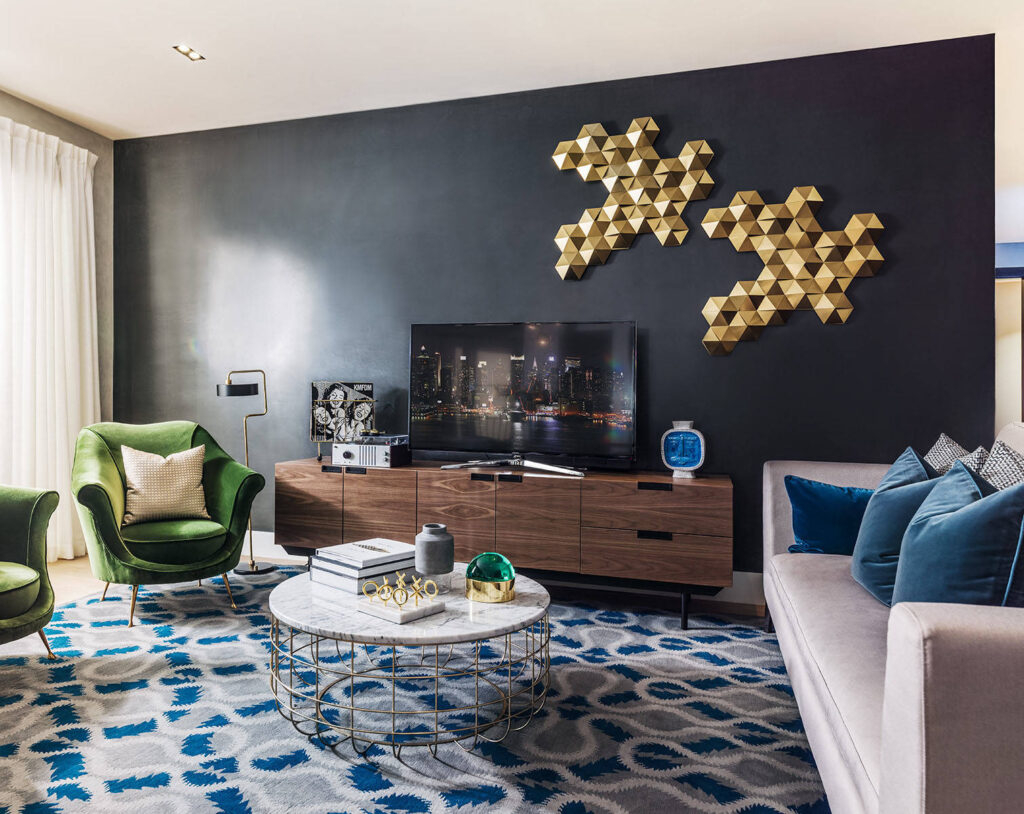
No matter what your taste is, whether contemporary or traditional, casual or formal, and sultry, your living room must be a space where you feel at ease and relax and spend time with your family, friends, or simply with yourself. There’sana an art of decorating a space that is pleasing and functions best for your personal preferences.
Therefore, before you embark on the process of redesigning your living room with a professional, take a look at a few design strategies and techniques. Here are a few of my top tips.
1. Mix Light and Dark
If your living space is bright and white, it may feel “clean” and unapproachable. If the room is dark, it could seem like a secluded cave. Mixing light and dark colors can create a lively design that’s full of harmony. The style of any room is enhanced by the addition of at least a touch of black and white.
2. Contrast Your Neutrals
Beyond adding the black and white, decorating a living room by using a variety of different neutral colors can go a long way towards making it feel luxurious and inviting. In this instance, there are white walls. The beige brick flooring and wall, as well as the caramel leather settee, pillows as well and the dark tables a white sofas all stand out against each other, highlighting their distinct finishes and undertones. The palette feels rich before any other crucial elements, like texture and pattern, are added.
3. Play With Texture
It’s easy to overlook texture when it comes to decorating a living room , as we aren’t able to see it as much as feel it. However, it’s essential to make your living space feel comfortable and inviting, which is why you should choose soft textures that appeal to the touch, as well as more textured textures that create contrast.
Use cotton, leather, wool, wool glass, stone, plant life, and as many different types of materials as you can. Pillows are a good starting point, particularly when you’re trying to decorate your living room that is on a budget. Check out other furniture and accessories to include new materials in the decor, even in small amounts.
4. Work in Some Wood
It’s impossible to talk about texture without speaking about wood, which is one of the best options for bringing a sense of warmth to your living space.
There are many ways to use wood. Any of them can make your space look more welcoming. Think about wall panels as well as table legs, side tables, stools, and picture frames, es couches, and art pieces that are carved, to name some of the many possibilities.
5. Mix Up Your Upholstery
Yes, a lot of furniture stores will give you the option of buying a complete living room set with matching furniture. However, this doesn’t mean you must make it a priority. If you’re in a formal space, the matching furniture can provide an impression of sophistication and order. But should you wish for your living space to feel comfortable and warm, combine and match your furniture to give your design an extra dimension.
One of the most secure methods to accomplish this is to mix leather furniture with a sofa made of fabric or, in reverse, so that the materials are contrasting in a way that is clearly intentional. It provides the design of the living room, and can provide family members with various options to meet their seating preferences.
6. Choose Practical Fabrics
In terms of upholstery, it’s crucial for the seating in your living room to be not just comfortable, but also durable. The way you define this will depend on the members of your family. There could be babies or children of a smaller size or pets, and they might be messy or neat. The majority of the time, mid-tone fabrics are the best option since light or dark shades can easily show dirt as well as wear. Denim as well as corduroy can be two materials that are both inviting and robust. Additionally, they provide an interesting twist when compared to the wool or plain cotton upholstery that you see in shops.
When selecting the fabric you will use for furniture in your living room, choose a material that is a mix of synthetic and natural fabrics to benefit from the practical aspects of both. If you can, try bending a swatch of fabric to make sure that the weave is tight and does not reveal the fabric backing. A tightly woven weave is more robust than a loose weave (which allows plenty of room for dirt to be hidden), regardless of the fabric.
7. Add a Dash of Color
While it is possible to create a stunning room without using any vibrant hues but adding just a shade of color to a living space can make a huge difference in creating a relaxing and welcoming atmosphere. When you are unsure, turn to a bright blueIt’s a shade that is generally a consensus among all. It’s a perfect match for warm materials like wood and leather, and is neutral enough to blend with virtually any other color scheme.
8. Add a Patterned Rug
Patterns are a potent design tool, bringing the living space to life and minimising the look of stains and wear. Rugs with patterns bring these advantages for your “fifth wall” — the floor — while anchoring the seating area and giving the entire space a feeling of vitality. Even if you have carpeting, think about installing a rug in your seating space. When you first pull it up to take to the washroom following an accident, you’ll feel thankful you put it in the place.
9. Choose Movable Tables and Stools
Tables, chairs, stools, ottomans, or even chairs for the side that move around quickly can make your living space more relaxing, offering your family and friends plenty of choices regularly to sit and relax, put your feet up, put a beverage down, or even seat guests.
Utilize a couple of smaller pieces, like footstools that are upholstered, to allow for mobility of the pieces closer and away from the primary seating area as required.
10. Consider Conversational Distances
Whatever the size of your living room is, there’s a limit on how big a seating arrangement can be. It can nevertheless be suitable for intimate conversations and intimate gatherings. The ideal distance between seats to allow for conversation is 8 feet. This means that if you have several sofas, or even a sofa and side chairs, your seating area must have the size of 8 feet or 4 feet in the direction of your center.
A massive 12-seat sectional sofa could seem impressive and perfect for a celebration, but if you’re hoping to create a relaxing living space, it’s better to choose smaller pieces of seating and move them closer together.







